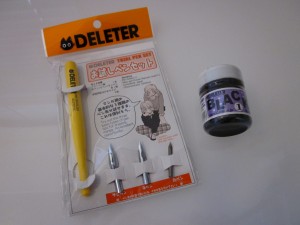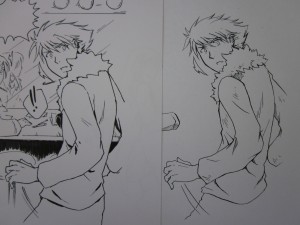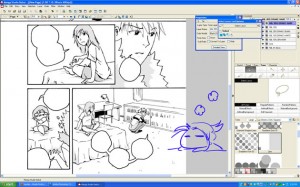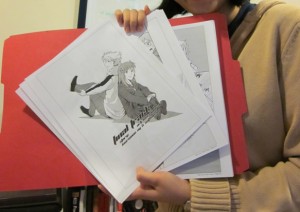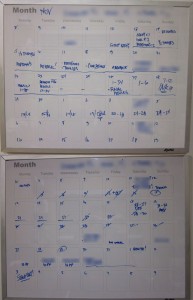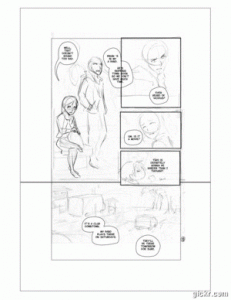Polterguys CH3 28-35 CH4 1-8 are up and Cover Design Notes
- At June 02, 2012
- By Laur
- In processes, updates
 4
4

Click to read new pages.
Everyone, meet Clive! He’s kind of a party pooper, huh?
Read More»How to Make Manga – Plan your Story
- At July 29, 2011
- By Laur
- In blog, processes
 0
0
I was in line for the Gallery Nucleus‘ Harry Potter Tribute Exhibition opening night the other weekend with some friends and by 9 PM, gave up on the idea I would make it to any of their advertised events. Seriously, it was like a Hall H line around the block and through the parking lot! I wasn’t too bitter though (I had a yummy dinner at Noodle World nearby) and was delighted so many people and their kids showed up and wanted to be part of the celebration.
Before I left, in the course of our conversation my friend asked me, “Wouldn’t it be great to create something this culturally relevant?”
I’m sure everyone reading this would answer a resounding, “YES! Ofcourse!” (and if you deny it, I think you’re probably not being honest with yourself XD). Everyone wants their beloved stories and creations to be appreciated. The especially fortunate few like JK Rowling have innumerable fans who not only love her books, but also everything that has to do with the world she created. They expand her established world by creating their own kinds of art (fanfics, fanart, costumes) and form communities that share their love for her stories.
I’ve always felt much respect and admiration for the storytellers whose works inspire such devotion and creative frenzy. Joss Whedon’s works (Buffy the Vampire Slayer, Angel, Firefly) and LOST, are a few more of my favorite stories with similar kinds of following. On the manga side, Hiromu Arakawa’s stellar work with Fullmetal Alchemist makes me weak in the knees and Naoki Urasawa’s handling of Pluto was very emotional.
It is somewhat intimidating to start off loving these phenomenal blockbusters and then, to ask yourself “What do I do to create something like that?” but I’m getting to the point of this post and it’s this: At the heart of each of these successful dramatic stories are characters. You may love the Harry’s wizarding world or enjoy deconstructing the Island’s mysteries but you tuned in and you stayed for the characters.
Creating compelling, sympathetic and memorable characters and giving them rich, believable and interesting stories is no easy feat. It takes time, lots of work and patience. In today’s fast-paced world, those are becoming rarities.
I’m discovering this gradual, fairly maddening process myself as I work on even more drafts for my story. As I suffer my way through rewrites this week, I take a lot of comfort in the fact that apparently, JK Rowling spent over five years planning Harry Potter’s story before she even started writing her first book. It makes me believe in the writing process and helps me be patient as I try to usher my story to be the best it can be.
Yes, my stories may never even be a fraction of the ginormous successes like Rowling’s or Whedon’s but if I plan it right, and respect the processes these creators share, no one can say I didn’t give it my best shot.
Some links I just wanted to share this week:
What if Harry Potter were an anime – a technically stunning anime illustration featuring Harry Potter characters by this PIXIV artist.
Another one equally as impressive is this Harry Potter collaborative piece by Rem and Maximo Lorenzo.
Evan Dahm wrote a tumblr post on how webcomics need to get better.
A post comparing Harry Potter, Tohru Honda and their respective villains. Fun read!
And finally, a must-read post on a now infamous SDCC panel and the questions about female DC creators/characters. Over at Comics Alliance, Laura Hudson’s response is equally fascinating and well-written.
How to Make Manga – Final Track Manga Process
- At July 27, 2011
- By Laur
- In processes
 1
1

Decided to compile a masterlist of the posts regarding my Final Track process. Hope you’ll find this useful!
This was a series of posts I wrote about how I made Final Track, a 34-page shojo manga I submitted for the Yen Press New Talent Search Fall 2010. I was contacted as a finalist in March 2011 and was given valuable feedback by the editors.
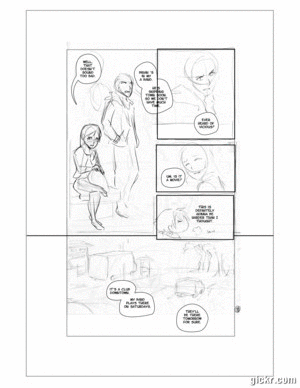
Part 2: Writing and Thumbnails
Nibs
- At April 21, 2011
- By Laur
- In blog, processes
 0
0
I bought a couple of things at Kinokuniya this weekend on a sort-of whim. I knew I wanted to keep experimenting with nibs but I already had a School G Pen and some Maru nibs. So far, they’ve been ok to use with the ink I had lying around. The School G skips on me sometimes but I think I effed it up one time when I didn’t use it for months. I didn’t have a sizable pen holder though so I splurged for the $12 to get the kit and some good ink and BOY oh, BOY am I glad I did~!
Wonky anatomy aside, I’ve been inking using both the Maru and G nibs on a few other pieces lying around (like Erza) and I’m absolutely digging the results. They look so different from the multiliner lines, it’s bananas. The quality also looks more confident despite my actual LACK of confidence putting down those lines HAHAHA. I really can’t wait to try these guys out on the comic pages I’m working on right now.
Comicking Part 5: Manga Studio and Etc.
- At April 11, 2011
- By Laur
- In blog, processes
 5
5
This is Part 5 of a series of posts I’m writing about how I made Final Track, a 34-page shojo manga I worked on as my submission for the Yen Press New Talent Search.
I usually ink all the pages completely before scanning everything. I know some people like completing one page at a time and that’s fine. We all have different preferences. I scanned these pages in at 600dpi even though 300dpi is the usual standard for printing. Unless your computer can handle the file size, I’d say 300 is fine. I save them as Bitmap files (.BMPs) and import them in Manga Studio.
Using Manga Studio seems to have been fairly intuitive enough that I managed to plow my way through after looking up processes and figuring out what commands did what. Suffice it to say that I’m much happier with the results from Manga Studio than trying to tone in Photoshop. The database of built-in tones by itself was a lifesaver and the ability to use gradient tones made achieving certain effects efficiently.
If you’re doing a comic specifically for print, it’s important that you actually see what it looks like on physical paper. You’re likely to discover things that jump out at you very differently from viewing on a screen. I’m always fortunate to have a very patient and detail-oriented sister willing to go over my work with a fine-toothed comb and point out areas for improvement. Afterwards, ofcourse, the next step involves implementing the feedback. It’s only after I’ve gone over everything again did I feel like the work was polished enough for presentation. It’s important to put your best foot forward.
If the process seems unwieldy and time-consuming, it really is and it will totally be your advantage to give yourself concrete and achievable deadlines. This will allow you to keep track of your progress and make adjustments to your schedule as needed. Final Track was a project I undertook for 2 months with full-time work. I did take a week off on Thanksgiving but the rest of the time, I spent working on it weeknights and weekends. I gave myself plenty of breaks so not to strain my body, ate well and slept regularly. No last minute rush jobs here because I hate doing that. Some people might be able to produce their best work under extreme pressure but I know I can’t. I’ve never been prone to pulling all-nighters because I just can’t recover from sleep debt as graciously as others can. So, I rely on strategies and planning ahead to make sure the work gets done.
Well, there you have it! This wraps up my behind-the-scenes look at Final Track and my comicking process. Hope y’all enjoyed!
Questions? Comments?
Previous Post: Comicking Part 4: Pencils, Bubbles & Inks

